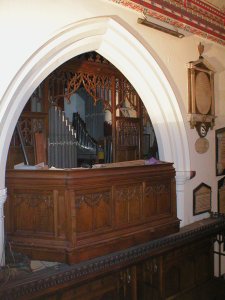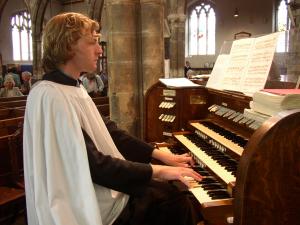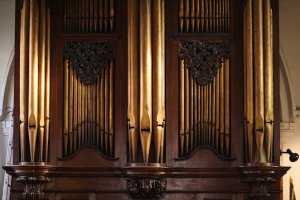
|
The organ of St Peter's Church, Nottingham
Part 1 - history and specification
...the murie orgon
On messe-dayes that in the chirche gon.
Chaucer
 Among the many
treasures of St Peter's Church the organ and the organ case must surely be outstanding.
As though this were not enough the organ has a history full of mystery and movement as if
it were an adventure story.
Among the many
treasures of St Peter's Church the organ and the organ case must surely be outstanding.
As though this were not enough the organ has a history full of mystery and movement as if
it were an adventure story.
Earliest information
There is a tradition that the organ was built by Green in 1770 for use in York Minster and to have been rebuilt by Lincoln and then installed in St Peter's. This however cannot be confirmed as in answer to a letter from Nottingham in 1941 the Registry of the Dean and Chapter of York say they have no record of this. There we have a mystery which later researchers may solve. There are however facts about the organ, the first of which is contained in a letter from Dr Leslie Sumner to Mr Vincent Trivett (for 40 years organist at St Peter's) dated 1934 in which he says:
as I was searching in the British Museum I came across this account by accident: 'St Peter's Nottingham (organ) built by Lincoln 1789/1864 opened August 1812'.
Another "fact" can be found on the brass plate on the organ in these words:
This organ was erected by subscription in the parish of St.
Peter Nottingham |
In 1816 the organist was paid £12-12-0 per annum. In 1814 it was resolved that no part of the cost of the organ or the organist should fall on church funds. In 1891 this decision was reaffirmed. After several small alterations the organ was sited in the west gallery of the steeple in 1821, where it remained until 1878 when it was removed to the chancel.
Old age
 Organs, like human beings, grow old and St Peter's organ began to show signs of old
age in the middle of the last century. Many letters and reports give details of the sad
state of the organ, one going as far as to say it was beyond repair. Over the years Wragg
& Son, organ builders, did yeoman service and many organists played as well as
possible on an ageing instrument, but they must have wondered how long this state of
affairs could last. Meanwhile old age crept on and in 1934 Dr Sumner, internationally
renowned as an authority on organs, was asked to make an examination and report. In his
own inimitable style he made several such comments as:
Organs, like human beings, grow old and St Peter's organ began to show signs of old
age in the middle of the last century. Many letters and reports give details of the sad
state of the organ, one going as far as to say it was beyond repair. Over the years Wragg
& Son, organ builders, did yeoman service and many organists played as well as
possible on an ageing instrument, but they must have wondered how long this state of
affairs could last. Meanwhile old age crept on and in 1934 Dr Sumner, internationally
renowned as an authority on organs, was asked to make an examination and report. In his
own inimitable style he made several such comments as:
as regards the tonal and mechanical side of the organ we are forced to say that both are entirely obsolete... no organist of repute would accept a recital engagement on the organ as it now stands... the action, despite constant small expenses merely to keep it in status quo, will collapse completely ere long... every pipe in the organ is to a greater or lesser degree inhibited in its speech through the dirt of years.
Two organs combined
 Any plans for a major
overhaul had to be postponed because of the 1939-45 war and the
crying need for repair work to be done on the fabric. In 1948 another report indicated
that the organ, now 160 years old, was in a parlous state:
Any plans for a major
overhaul had to be postponed because of the 1939-45 war and the
crying need for repair work to be done on the fabric. In 1948 another report indicated
that the organ, now 160 years old, was in a parlous state:
most of the notes in the last (bass) octave will not play at all... the console is obsolete... the metal pipes have gone soft owing to their great age and are bending over like blades of grass in all directions.
Mr Vincent Trivett, now Chairman of the Organ Fund, was behind the work now undertaken. St Peter's bought the organ of St Columba's Church in Mansfield Road, and the repairs and the blending together of the two organs was undertaken by Fenton Wragg. At this time the action was electrified and the console was hoisted through the chancel roofing into a new position. The organ was rededicated on Palm Sunday 1952.
Overhauls and revoicing
In 1964 the national firm of Henry Willis and Sons were invited to work on the organ. This included a complete cleaning and thorough overhaul as well as entire revoicing of the pipework and some excellent additions especially on the choir organ to make the performance of baroque and romantic music possible. Throughout the 30 years of Canon Inglis as Rector he was concerned that the organ should be so maintained that it was both superb and versatile.
In 1983 the biggest of all the many overhauls was undertaken. The console was moved yet again to be sited on the south side of the new dais, at the east end of the south aisle. The whole organ was examined and all necessary renewals made, including revoicing and the insertion of a memory capture system. This restoration undertaken by Hill, Norman & Beard means we now have a traditional English organ (somewhat rare these days) capable of a full musical range, a console visually satisfying, in a position central to worship.
The Snetzler case
 It is impossible to write about the organ without mentioning the
organ case of c.1770, attributed to John Snetzler. For many years the case was tucked away
out of sight in the Chancel, but following the report of Dr Sumner in 1934 it was removed
to its present site at the east end of the north aisle where it can be seen in its full
beauty. In Dr Sumner's words:
It is impossible to write about the organ without mentioning the
organ case of c.1770, attributed to John Snetzler. For many years the case was tucked away
out of sight in the Chancel, but following the report of Dr Sumner in 1934 it was removed
to its present site at the east end of the north aisle where it can be seen in its full
beauty. In Dr Sumner's words:
English organ cases of artistic value are extremely rare, but here is an example of great beauty... it is to be deplored that when so many churches are marred by hideous rows of zinc chimney cans masquerading as organ cases St Peter's hides its very beautiful light under a bushel... the case should be erected in the north chancel facing the nave and visible immediately on entry.
Tradition has always named St Peter's case as the work of Snetzler and in the 3rd edition of Dr Sumner's book The Organ (1986) it is not only named as such in the text but one of the plates is entitled "Snetzler's case, St Peter's Nottingham". Now however, with new tests etc. some doubt is being cast on it being the work of the master, and we must of course keep an open mind and respect the new technology. In spite of this the beauty of the organ case is unimpaired, and it is fair to predict it will continue to be called by the name of Snetzler!
Specification
| Swell (enclosed) | Great | ||
| 1. Double Diapason | 16' | 21. Bourdon | 16' |
| 2. Geigen | 8' | 22. Large Open Diapason | 8' |
| 3. Rohr Flute | 8' | 23. Small Open Diapason | 8' |
| 4. Salicional | 8' | 24. Hohl Flute | 8' |
| 5. Voix Celeste | 8' | 25. Principal | 4' |
| 6. Salicet | 4' | 26. Harmonic Flute | 4' |
| 7. Mixture | II | 27. Twelfth | 2 2/3' |
| 8. Oboe | 8' | 28. Fifteenth (from 25) | 2' |
| 9. Contra Fagotto (fr. 10) | 16' | 29. Mixture | III |
| 10. Cornopean | 8' | 30. Trumpet | 8' |
| 11. Clarion (from 10) | 4' | 31. Clarion (from 30) | 4' |
| Swell Octave & Sub | Swell to Great | ||
| Choir | Pedal | ||
| 12. Keraulophon | 8' | 32. Resultant Bass (fr. 34) | 32' |
| 13. Viola | 8' | 33. Open Diapason | 16' |
| 14. Gedact | 8' | 34. Sub Bass | 16' |
| 15. Coppel | 4' | 35. Echo Bourdon (from 21) | 16' |
| 16. Piccolo (from 14) | 2' | 36. Viola (from 13) | 8' |
| 17. Sext | 12,17 | 37. Octave (from 33) | 8' |
| 18. Krummhorn | 8' | 38. Bass Flute (from 34) | 8' |
| 19. Trumpet (from 30) | 8' | 39. Octave Flute (from 34) | 4' |
| 20. Clarion (from 30) | 4' | 40. Trombone (from 30) | 16' |
| 41. Trumpet (from 30) | 8' | ||
| Choir Octave & Sub | Great, Swell | ||
| Swell to Choir | and Choir to Pedal |
Hill, Norman & Beard - 1983 rebuild
Addendum
I am grateful to Andrew Abbott, Assistant Organist at St Mary's Church, for the following additional information.
I have quite a bit of information on the organ and organists of St Peter's which I collected when John Whittle and I did our research for our book on the same subject for St Mary's. I have a note that St Peter's organ was rebuilt in 1863 by Lloyd and Dudgeon and again in 1876 when it was moved from under the tower to the north side of the chancel. The organ was again rebuilt by Lloyd in 1911 and then by E. Wragg and Sons in 1952.
The interior of the organ
The organ of St Peter's, part 2 - photographs of the interior.
Hear the organ
| Chorale Prelude on "St Peter" - Harold Darke NEW | MP3 (1.8Mb) |
| Scherzo (Sonata no. 5) - Alexandre Guilmant NEW | MP3 (5.1Mb) |
Played by Kendrick Partington Organist Emeritus
during a recital given at St Peter's on 30th June 2001.
These MP3 files are encoded at 96Kbps: 13.5kHz stereo.
EMOR mailing list
If you are interested in receiving email notification of organ recitals in the East Midlands, then why not subscribe to EMOR? "East Midlands Organ Recitals" is a mailing list which will send you occasional emails containing details of recitals in Derbyshire, Leicestershire, Lincolnshire and Nottinghamshire. To join, simply send an email to emor-subscribe@yahoogroups.com.
Return to the Music contents page
http://www.stpetersnottingham.org/music/organ.htm
© St Peter's Church, Nottingham
Last revised 26th February 2006